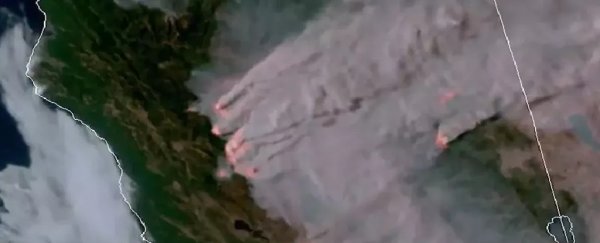Firefighters on Sunday battled some of California's largest-ever fires that have forced tens of thousands from their homes and burned one million acres, with further lightning strikes and gusty winds forecast in the days ahead.
Thousands of lightning strikes have hit the state in the past week, igniting fires that left smoke blanketing the region, bringing the total area burned to "close to one million acres," or 400,000 hectares, according to CalFire public information officer Jeremy Rahn.
That is considered a stunning toll this early in California's fire season, which normally runs from August to November, and it comes as exhausted firefighters are already struggling to keep up with the far-flung blazes.
The National Weather Service said dry thunderstorms could spark additional wildfires, adding that "the western US and Great Plains are shrouded under a vast area of smoke." It issued red-flag warnings covering large swaths of northern and central California.
Quick snapshot of the view from the ground of the SCU Lightning Complex damage. 💔 pic.twitter.com/NEdqzJVdm0
— Gavin Newsom (@GavinNewsom) August 23, 2020
These conditions "could cause erratic winds, extreme fire behavior within the existing fires, and have a potential for new fires to start," the CalFire website said.
Firefighters are stretched so thin that the state has turned down some local officials' requests for help with equipment or personnel, forcing them to rely on volunteers and local agencies, the Los Angeles Times said.
About 2,600 firefighters are now tackling the two largest blazes, out of roughly 14,000 battling "nearly two dozen major fires," according to Rahn.
With California pleading for outside help, several western states, the federal government and even the governments of Canada and Australia have responded.
"Many of these firefighters have been on the lines for 72 hours, and everybody is running on fumes," Assemblyman Jim Wood of the Healdsburg district in Sonoma told the Los Angeles Times. "Our first responders are working to the ragged edge of everything they have."
The disparate force battling the many blazes now includes 2,400 fire engines, 60 of them from other states, with several hundred more requested, CalFire said.
More than 200 aircraft, including 95 fixed-wing planes, are taking part in what CalFire spokesman Daniel Berlant called "a significant air force" dropping loads of water, monitoring the spread of flames or ferrying firefighters and equipment.
Some 200 National Guardsmen have also been mobilized to help, he added.
Governor Gavin Newsom on Saturday posted a dramatic photograph of clouds of smoke rising from fires. "This is from today," he said, "and is just a small part of the nearly 600 fires we are battling this week."
He said Saturday that the White House had granted a request for a presidential disaster declaration to aid in the state's response.
If you don’t believe in climate change, come to California.
— Gavin Newsom (@GavinNewsom) August 23, 2020
This is from today. And is just a small part of the nearly 600 fires we are battling this week. pic.twitter.com/iv4stV3Aax
He tweeted apocalyptic images of smoldering orange roadsides thick with smoke, with sparks flying as trees burned ferociously.
Wineries in the famed Napa and Sonoma regions, which are still reeling from blazes in recent years, are under threat.
Not all have evacuated
The two largest blazes - the SCU Lightning Complex to the south of the San Francisco Bay area, and the LNU Lightning Complex to the north - have burned about 680,000 acres and destroyed more than 850 structures.
They are the second and third largest fires in California history, with the SCU fire only 10 percent contained and the LNU fire 17 percent contained.
Five deaths have been linked to the latest flare-ups, with four bodies recovered on Thursday, including three from a burned house in a rural area of Napa County.
But many residents have refused evacuation orders.
"At least if we're here, we know exactly what's going on," Napa resident John Newman, 68, told the San Francisco Chronicle as he sat in a lawn chair in his driveway. "Family is worried, but it's a little different if you're here firsthand."
Nature reserves were also ravaged. The Big Basin Redwoods State Park said that some of its historic buildings had been destroyed by flames.
The park, where giant redwood trees of well over 500 years old can be found, was "extensively damaged," it said.
About 119,000 people have been evacuated, with many struggling to find shelter and hesitating to go to centers set up by authorities because of coronavirus risks.
In some counties south of San Francisco, evacuees opted to sleep in trailers along the Pacific Ocean as they fled nearby fires, while tourists were urged to leave to free up accommodation.
California has already been struggling, more than most with US states with the coronavirus. The combination of that disease and the thick smoke from wildfires has caused what the San Francisco Chronicle called "a respiratory nightmare".
A doleful headline in the paper asked, "What masks can protect you from both smoke and COVID-19?"
